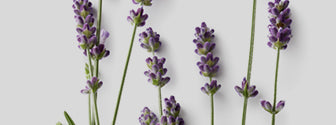Lavender (Lavandula angustifolia) is a member of the Lamiaceae (Mint) family. Other members of the mint family include rosemary, sage, peppermint, skullcap, and catnip. Botanical characteristics of lavender include a stalk that is square and simple with irregular flowers. The calyx or sepals is five-toothed and two-lipped. The calyx (bud) is the tubular structure that remains to produce seed. The calyx color is what gives dried lavender buds their color. It flowers between July and September and the seeds ripen between August and October.
Lavender is considered easy to cultivate especially for someone who is new to growing a medicinal garden. Stem-cutting is one method of propagation. Lavender flowers contain volatile oil containing linalyl acetate and linalool, geraniol, cineole, limonene, and sesquiterpenes.1-5
Therapeutic Actions of Lavender
The purported therapeutic actions of lavender are as a carminative which means it affects gastrointestinal gas production.*6 It also affects muscle tension and mood.*7,8,9 Lavender is thought to dilate capillaries and increase blood circulation via topical application and inhalation, provide gastric soothing properties, and is additionally categorized as a nervine meaning it supports the nervous system.*10-13 Interestingly, the essential oil of lavender is noted in the Materia medica as one phytotherapeutic not to be used internally. However, newer research offers a contrary point of view with human clinical trials supporting the use of oral lavender essential oil.
Mechanism of Oral Lavender
The mechanism of how oral lavender works is a matter of conflict. In contrast to initial speculations that the anxiolytic action of lavender oil is caused by an effect on the GABAA receptors similar to conventional agents a more recent study did not identify any interaction of oral lavender to known targets of conventional agents such as the GABAA-receptor, norepinephrine, serotonin, dopamine transporters, or monoamine-oxidase-A (MAO-A).*14 Instead, oral lavender caused a potent inhibition of voltage dependent calcium channels (VDCCs) in synaptosomes.*15
Voltage-dependent calcium channels regulate the intracellular calcium concentration and contribute thereby to calcium signaling. The opening of these channels is primarily regulated by the membrane potential, but is also modulated by a wide variety of hormones, protein kinases, protein phosphatases, toxins, and drugs. These channels are an essential part of many excitable and non-excitable cells.16
The term “synaptosome” was first mentioned in a paper published in 1964.17 Synaptosomes are membranous sacs that contain synaptic components. They contain the complete presynaptic terminal, including mitochondria and synaptic vesicles, along with the postsynaptic membrane and the postsynaptic density (PSD).18
The primary action of lavender (Lavandula angustifolia) which supports mood is thought to take place in hippocampal neurons.* This mechanism of action when stated in this way may sound familiar to conventional agents which are known to support comfort. However, upon closer evaluation, it is now known that the mechanism of action of lavender is, in fact, unique as it does not bind to certain binding sites that the conventional agents do.19
The stress response of the central nervous system and of the hippocampus in particular where the inhibition by oral lavender was shown to be mainly mediated via N-type and P/Q-type VDCCs is linked to mood.*20 In another clinical trial in healthy volunteers, oral lavender significantly reduced the serotonin-1A receptor (5-HT1A) binding potential in the brain clusters encompassing the temporal gyrus, the fusiform gyrus, the hippocampus, the insula, and the anterior cingulate cortex.*21
REFERENCES
- Liao X et al. Guang Pu Xue Yu Guang Pu Fen Xi. 2015 Sep;35(9):2526-9.
- Deng XY et al. PhysiolBehav. 2015 Dec 1;152(Pt A):264-71.
- Carrasco A et al. Planta Med. 2016 Jan;82(1-02):163-70.
- Carrasco A et al. Planta Med. 2016 Jan;82(1-02):163-70.
- Lemberkovics E et al. Acta Pharm Hung. 1998 May;68(3):141-9.
- Lis-Balchin M et al. Phytother Res. 1999 Sep;13(6):540-2.
- Lis-Balchin M et al. Phytother Res. 1999 Sep;13(6):540-2.
- Effati-Daryani F et al. J Caring Sci. 2015 Mar 1;4(1):63-73.
- Kasper S et al. Eur Neuropsychopharmacol. 2016 Feb;26(2):331-40.
- Shimada K et al. Hypertens Res. 2011 Feb;34(2):264-7.
- Shiina Y et al. Int J Cardiol. 2008 Sep 26;129(2):193-7.
- Lis-Balchin M et al. Phytother Res. 1999 Sep;13(6):540-2.
- Ghods AA et al. Complement Ther Med. 2015 Jun;23(3):325-30.
- Huang L et al. J Pharm Pharmacol. 2008 Nov;60(11):1515-22.
- Schuwald AM et al. PLoS One. 2013 Apr 29;8(4):e59998.
- Hofmann F et al. Rev PhysiolBiochemPharmacol. 1999;139:33-87.
- Whittaker VP et al. Biochem J. 1964 Feb;90(2):293-303.
- Bai F, Witzmann FA et al. Sub-cellular biochemistry. 2007;43:77-98.
- Schuwald AM et al. PLoS One. 2013 Apr 29;8(4):e59998.
- Satpute AB et al. Emotion. 2012 Feb;12(1):58-68.
- Baldinger P, Höflich AS, Mitterhauser M, et al. Int J Neuropsychopharmacol. 2014 Oct 31;18(4).



